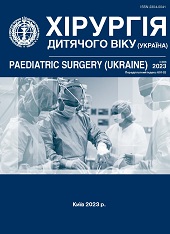Ureteral obstruction after endoscopic treatment of the vesicoureteral reflux in children
DOI:
https://doi.org/10.15574/PS.2023.80.78Keywords:
vesicoureteral reflux, ureteral obstruction, risk factors, childrenAbstract
Purpose - to investigate the ureteral obstruction (UO) frequency after endoscopic injection of the vesicoureteral reflux (VUR) in children.
Materials and methods. 1068 children aged 8 months -15 years were respectively reviewed after endoscopic treatment of the VUR grades 2-4. The following factors were analyzed in terms of ureteral obstruction: age, sex, reflux grade. Also the clinical manifestations were reviewed as the ureteral obstruction management types (conservative - 28 (52.8%), stenting - (26.5%), reimplantation of the ureter - 11 (20.7%) as well.
Statistical analysis of the frequency of OS (categorical data) was performed using nonparametric estimation methods (χ², Fisher's exact test). A difference of p<0.05 was considered statistically significant.
Results. The total incidence of ureteral obstruction was 3.44% (53/1539 ureters). There were early (41 children) and late (12 children) obstructed units. The following risk factors for developing ureteral obstruction proved to be significant: sex (males), low reflux grade. The early UO was treated mostly with watchful waiting, stenting (13 cases) and 2 cases were submitted to open surgery. In late UO ureteral reimplantation was utilized (9 cases) as well as ureteral stenting was helpful.
Conclusions. UO is an infrequent but essential complication of the endoscopic VUR correction. The early UO cases are effectively treated by watchful waiting with/without empty bladder or ureteral stenting. Ureteral reimplantation seems to be the main procedure in late UO cases.
The research was carried out in accordance with the principles of the Helsinki Declaration. The study protocol was approved by the Local Ethics Committee of all participating institutions. The informed consent of the patient was obtained for conducting the studies.
No conflict of interests was declared by the authors.
References
Alizadeh F, Mazdak H, Khorrami MH, Khalighinejad P, Shoureshi P. (2013, Aug). Postoperative ureteral obstruction after endoscopic treatment of vesicoureteral reflux with polyacrylate polyalcohol copolymer (Vantris®). Journal of Pediatric Urology. 9; 4: 488-492. https://doi.org/10.1016/j.jpurol.2012.11.007; PMid:23219423
Chertin B, Mele E, Kocherov S, Zilber S, Gerocarni Nappo S, Capozza N. (2018). What are the predictive factors leading to ureteral obstruction following endoscopic correction of VUR in the pediatric population? J Pediatr Urol. 8: 510-517.
Chung JM, Park ChS, Lee SD. (2015, Jul). Postoperative ureteral obstruction after endoscopic treatment for vesicoureteral reflux. Korean J Urol. 56 (7): 533-539. https://doi.org/10.4111/kju.2015.56.7.533; PMid:26175873 PMCid:PMC4500811
Escolino M, Kalfa N, Castagnetti M, Caione P et al. (2023). Endoscopic injection of bulking agents in pediatric vesicoureteral reflux: a narrative review of the literature. J Pediatric Surgery International. 39: 133. https://doi.org/10.1007/s00383-023-05426-w; PMid:36806763 PMCid:PMC9938816
Friedmacher F, Puri P. (2019). Ureteral obstruction after endoscopic treatment of vesicoureteral reflux: does the type of injected bulking agent matter? Curr Urol Rep. 20 (9): 49. https://doi.org/10.1007/s11934-019-0913-5; PMid:31289951
Garcia-Aparicio L, Rodo J, Palazon P, Martin O, Blazquez-Gomez E, Manzanares A et al. (2013). Acute and delayed vesicoureteral obstruction after endoscopic treatment of primary vesicoureteral reflux with dextranomer/hyaluronic acid copolymer: why and how to manage. J Pediatr Urol. 9: 493-497. https://doi.org/10.1016/j.jpurol.2013.02.007; PMid:23507288
Mazzone L, Gobet R, Gonzalez R, Zweifel N, Weber DM. (2012). Ureteral obstruction following injection of dextranomer/hyaluronic acid copolymer: an infrequent but relevant complication. J Pediatr Urol. 8: 514-519. https://doi.org/10.1016/j.jpurol.2011.10.002; PMid:22023846
Nakonechnyy RA, Prytula VP, Nakonechnyy AI. (2017). Complication of intravesical correction of vesicoureteral reflux in children. Paediatric surgery. Ukraine. 4 (57): 72-79. https://doi.org/10.15574/PS.2017.57.72
Papagiannopoulos D, Rosoklija I, Cheng E, Yerkes E. (2017). Delayed obstruction with asymptomatic loss of renal function after dextranomer/hyaluronic acid copolymer (Deflux) injection for vesicoureteral reflux: a close look at a disturbing outcome. Urology. 101: 63-66. https://doi.org/10.1016/j.urology.2016.09.013; PMid:27687330
Rubenwolf PC, Ebert AK, Ruemmele P, Rösch WH. (2013). Delayed-onset ureteral obstruction after endoscopic dextrano-mer/hyaluronic acid copolymer (Deflux) injection for treat-ment of vesicoureteral reflux in children: a case series. Urology. 81 (3): 659-662. https://doi.org/10.1016/j.urology.2012.11.044; PMid:23452811
Serdar T. (2015, May 5). Guidelines on paediatric urology. European Association of Urology. European Society for Paediatric Urology. URL: http://uroweb.org/wp-content/uploads/EAU-Guidelines-Paediatric-Urology-2015.pdf.
Serrano Durba A, Bonillo García MA, Moragues Estornell F, Domínguez Hinarejos C, Sanguesa C, Martínez Verduch M, García Ibarra F. (2006, Feb). Vesicoureteric reflux endoscopic treatment complications in childhood. Actas Urol Esp. 30 (2): 170-174. Spanish. https://doi.org/10.1016/S0210-4806(06)73419-2; PMid:16700207
Snodgrass WT. (2004). Obstruction of a dysmorphic ureter following dextranomer/hyaluronic acid copolymer. J Urol. 171: 395-396. https://doi.org/10.1097/01.ju.0000101995.85004.95; PMid:14665941
Yankovic F, Swartz R, Cuckow P, Hiorns M, Marks SD, Cherian A et al. (2013). Incidence of Deflux® calcification masquerading as distal ureteric calculi on ultrasound. J Pediatr Urol. 9; 6pt A: 820-824. https://doi.org/10.1016/j.jpurol.2012.10.025; PMid:23186595
Downloads
Published
Issue
Section
License
Copyright (c) 2023 Paediatric Surgery (Ukraine)

This work is licensed under a Creative Commons Attribution-NonCommercial 4.0 International License.
The policy of the Journal “PAEDIATRIC SURGERY. UKRAINE” is compatible with the vast majority of funders' of open access and self-archiving policies. The journal provides immediate open access route being convinced that everyone – not only scientists - can benefit from research results, and publishes articles exclusively under open access distribution, with a Creative Commons Attribution-Noncommercial 4.0 international license(СС BY-NC).
Authors transfer the copyright to the Journal “PAEDIATRIC SURGERY.UKRAINE” when the manuscript is accepted for publication. Authors declare that this manuscript has not been published nor is under simultaneous consideration for publication elsewhere. After publication, the articles become freely available on-line to the public.
Readers have the right to use, distribute, and reproduce articles in any medium, provided the articles and the journal are properly cited.
The use of published materials for commercial purposes is strongly prohibited.

